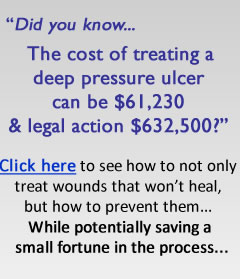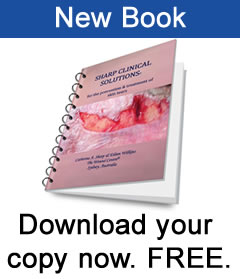We’re out of Silicone dressings…just use a Hydrocolloid…
How many times has this happened to you when you’re charged with the most important job of the day — wound care??
But Silicone dressings are not the same as Hydrocolloid dressings!
Now don’t get me wrong… I love hydrocolloids! In fact they were the first ‘second generation’ dressing I was introduced to in 1989 … and that’s when I began my love affair with wound care.
Nothing was ever the same … we moved from gauze dressings, changed every four hours, to hydrocolloid dressings that could remain in place for up to a week. Magic!
Now I still love hydrocolloids (e.g. DuoDerm and Comfeel) but not for frail [ageing] skin. They stick too well to skin, so much so that when they are removed from frail skin they can take a layer of skin with them causing a lot of pain…and making the wound much larger than it was.
So please do not use hydrocolloids on frail skin, e.g. on skin tears in the aged. Use ONLY silicone dressings (e.g. Biatain Silicone Foam, Mepilex Border or Allevyn Gentle Border).
Download the free book SHARP CLINICAL SOLUTIONS© for the prevention and treatment of skin tears from this website www.thewoundcentre.com
Do you really need NPWT or will a simple dressing suffice…?
What if a simple wound dressing could do the job of a negative pressure wound therapy (NPWT) device AND save you heaps and heaps of money?
You could make your life, and that of your patient’s life, so, so much easier. Think about it…
The NPWT device has lots of advantages e.g. in large open wounds with lots of exudate but many more disadvantages I think. Patient mobility can be seriously reduced. There is a skill to applying NPWT; you must create a really good vacuum seal otherwise it simply won’t work… it takes practice and time!
Hydration Response Technology i.e. the sorbion sachet s wound dressing, on the other hand, has many more advantages than disadvantages. It also works well in large exuding wounds, reduces nursing time, is really quick & easy to apply, reduces bacterial burden and modulates MMPs.
I have used sorbion sachet s and am so impressed. But if you haven’t already tried it and need convincing why not read Keith Cutting’s paper first?
Just copy and paste the authors & title into your browser or click on the web link below.
Cutting KF, Hermans M, Kwon Lee S, Wolcott R, Treadwell T. Key considerations in choice of wound management therapeutics between an advanced wound care dressing utilising Hydration Response Technology or a durable medical device NPWT. Chorleywood, UK, Health Directions, 2011.
http://www.karrasmedical.com/files/clinical%20resources/Anaheim_Report_2011_Druckdatei.pdf
Kate Sharp
Reducing Avoidable Pressure Injuries
I am delighted to tell you about the inaugural Reducing Avoidable
Pressure Injuries Conference in Melbourne on 20 & 21 September 2012.
The conference details can be viewed online at
http://www.iir.com.au/conferences/healthcare/reducing-avoidable-pressure-injuries-conference
Come & join us at this great event – you might be interested in
presenting in future years’ events of this kind.
What is the effect of silver on breastfeeding?
I must say this is something I had never thought of, perhaps because I am not a midwife, but we do need to consider the risks to the infant when breastfeeding mothers are exposed to silver.
This happens when dressings containing silver are used in the management of caesarean section wounds for example.
Read this enlightening paper by
Alison Johnstone, Katrina McGown, Martyn Butcher and Richard White
British Journal of Midwifery June 2012 Vol 20, No 6
you can find it on the following websites:
www.britishjournalofmidwifery.com/
or
www.intermid.co.uk
Moisture may influence the mechanisms of skin damage but…
The web is huge and it’s a real benefit to have a place where you can find, share and comment on, wound care information, instantly.
It’s not that long ago, in August 1991 to be precise, that Sir Tim Berners-Lee created the first website. He called it the ‘Read/Write Web’…’a collaborative medium, a place where we [could] all meet and read and write’. [1]
And that is exactly what happens on this website…a place where we ‘meet and read and write.’
After I posted ‘Incontinence does not cause pressure injuries!’ six months ago, people I have never met; Richard White, Karen Ousey, Martyn Butcher and Colin Iverson responded, via blog and email. Together we shared lots of information on the subject of pressure injury and incontinence then focussed on one particularly relevant paper by Zena Moore & Seamus Cowman.[2] Over a period of weeks we wrote a response to their paper [3] which we’d like to share with the world.
‘Response to Moore Z & Cowman S (2012) Pressure ulcer prevalence and prevention practices in care of the older person in the Republic of Ireland, Journal of Clinical Nursing 21, 362-371′ written by
Catherine A Sharp, Richard White, Karen Ousey, Martyn Butcher and Colin Iversen
And now we’d love to read your responses!
[1] Berners-Lee on the read/write web. BBC News. 2005-08-09. http://news.bbc.co.uk/2/hi/technology/4132752.stm.
[2] Moore, Z. and Cowman, S. (2012), Pressure ulcer prevalence and prevention practices in care
of the older person in the Republic of Ireland. Journal of Clinical Nursing, 21: 362–371
[3] http://onlinelibrary.wiley.com
/doi/10.1111/j.1365- 2702.2011.03749.x/abstract;jsessionid=37868D4184954B74183B012E5B5951B8.d03t02


